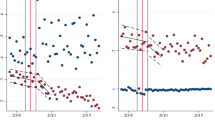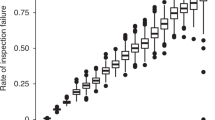Abstract
The goal of this paper is to examine the timing of environmental compliance inspections and determine the extent to which such inspections can be predicted. The paper focuses on modeling the inspections at hazardous waste facilities in the U.S. using detailed data on individual inspections and facilities. The paper uses a number of parametric and semi-parametric duration models to predict the timing of inspections and finds that the exponential model provides the best balance in terms of the explanatory power and simplicity of the model. However, even with this model it is difficult to accurately predict the timing of most compliance inspections. The paper also examines the extent to which using data on individual inspections can improve empirical predictions about aggregate inspections. If the goal is to estimate the annual number of inspections at hazardous waste facilities, neither the exponential model or a Poisson model is clearly superior. Which model is more appropriate depends on the question the researcher wants to answer. Similarly, if the focus is on whether any inspection occurred in a given time period, the benefits of using the exponential model depend on the nature of the questions to be answered. While the exponential model performs better than a probit model in predicting which entities will be inspected, it also results in a higher number of “false positives,” that is predicting an inspection when no inspection actually occurs.





Similar content being viewed by others
Notes
See Gray and Shimshack (2011) for a comprehensive survey of the empirical literature on environmental monitoring and enforcement.
For example, Section 3007 of the Resource Conservation and Recovery Act requires that EPA or an authorized state conduct a program to “thoroughly inspect” every hazardous waste treatment, storage, or disposal facility “no less often than every two years” (42 U.S.C. § 6927).
See Polinsky and Shavell (2000) for an overview of this literature.
Nadeau (1997) estimates a duration model of plant non-compliance in the U.S., but chooses to model inspections as a Poisson process.
Programs can co-operate and conduct multi-media inspections, but the majority of inspections are single program inspections.
Both the Clean Air Act and Clean Water Act require regulated entities to self-report compliance status.
Under the U.S. Supreme Court decision in Marshall v. Barlow [(436 U.S. 307, 322-24 (1978)], business owners and operators have an expectation of privacy against unreasonable administrative searches of their commercial property and warrantless searches cannot generally be conducted. However, there is an exception for “pervasively regulated businesses” subject to “longstanding governmental regulation.” Additionally, probable cause for obtaining a warrant can be established by showing that the entity is being inspected according to a neutral inspection regime. In practice, few entities challenge EPA inspections without warrants (Steinway 2009).
Under Section §3006 of RCRA, EPA may authorize qualified states to administer and enforce their own hazardous waste program. States with final authorization administer their hazardous waste programs in lieu of EPA’s federal program. However, even in states with final authorization, EPA retains the authority to conduct independent inspections and can enforce any provision of an authorized state’s approved program, including state requirements that are more stringent than the federal requirements.
RCRAInfo is EPA’s primary database for all facilities regulated under RCRA. It contains data on all inspections and enforcement actions conducted under RCRA’s authority.
Over 95 % of inspections list only one type of inspection and one inspection agency. For the remaining inspections, a primary inspections type and/or primary inspector type was assigned based on author-created hierarchies. Details are available upon request.
See Wooldridge (2010, Chap. 22) “Duration Models” for a more comprehensive discussion of the use of survival models.
One can also use a non-parametric estimator of the survivor function, the Kaplan–Meier estimator, which does not allow for explanatory variables but instead only uses observed spell durations. This study does not use such an approach because a preliminary analysis showed that the differences between the Kaplan–Meier estimates for various subsets of the data were statistically significant. Thus the explanatory variables used in the model are important in predicting the duration of spells.
Cox (1972) presents the partial likelihood estimator
Conditionally exempt generators generate less than 100 kg (220 lb) of hazardous waste, or less than 1 kg (2.2 lb) of acutely hazardous waste, per calendar month. These facilities are subject to many fewer regulations than facilities that generate larger quantities of hazardous waste.
A large quantity generator is any facility that generates more than 1,000 kg (2,200 lb) of hazardous waste per calendar month, or more than 1 kg (2.2 lb) of acutely hazardous waste per calendar month.
Since biennial reports are filed only for the odd years, information from the 1999 reporting cycle is used to infer that a facility was active in 2000 and from the 2009 cycle to infer that a facility was active in 2010.
Details on the hierarchies provided upon request.
Most of these excluded inspections represent a small percentage of total inspections. Financial and non-financial record reviews represent about 20 % of all inspections, but are excluded because they are not field inspections.
Rousseau (2007) runs separate regressions for three different types of inspections: routine, reactive, and project-related. This study separates compliance inspections from non-compliance inspections, but does not further separate compliance inspections for two reasons. First, the RCRAInfo dataset does not provide enough information to separate routine, reactive, and project-related inspections. Second, while there are different types of compliance inspections included in the analysis, the decision of when to inspect and what type of inspection to conduct are likely co-determined. This analysis focuses on estimating the timing of the regulator’s decision rather than the type of inspection that the regulator chooses to conduct.
Positive coefficients correspond with hazard ratios that are greater than 1 (i.e., and increase in the hazard) and negative coefficients correspond with hazard ratios that are less than one.
Ohio is the omitted state.
Of course, the number of coefficients that are significant and the signs of those coefficients depend on which state is excluded from the analysis.
The results for the Weibull and Gompertz models are available upon request.
The exponential and Weibull models can also be interpreted as accelerated time-failure models, but the Gompertz cannot.
The Poisson regression, unlike a standard OLS regression, takes into account the fact that the number of inspections is a count variable, i.e, a non-negative integer.
While there were 6,430 entities in the initial database, recall that the exponential model uses state-specific data, and thus 48 entities in DC, Puerto Rico, Guam, and the Virgin Islands were dropped from the analysis.
In the exponential analysis, there is a set of variables capturing the number of inspections and violations conducted at the facility in the 12 months and 5 years prior to the start of each spell. For the Poisson analysis similar variables are constructed for the 12 months and 5 years prior to the start of each calendar year.
Although the Poisson model takes into account the integer nature of the inspection variable, the prediction the model generates is the estimated mean of the number of inspections. Therefore the Poisson predictions are rounded to the nearest integer to identify “correct predictions.”
Because the probit model predicts a probability of inspection, for any observation where the predicted probability of an inspection was greater than 0.5, the probit model is credited with a predicted inspection.
References
Becker, G. S. (1968). Crime and punishment: An economic approach. Journal of Political Economy, 76, 169–172.
Cohen, M. (1999). Monitoring and enforcement of environmental policy. In Tom T. & Henk F. (Eds.), International yearbook of environmental and resource economics, III. Cheltenham, UK: Edward Elgar Publishing.
Cox, D. R. (1972). Regression models and life—Tables. Journal of the Royal Statistical Society, 34, 187–220.
Earnhart, D. (2004). Regulatory factors shaping environmental performance at publicly owned treatment plants. Journal of Environmental Economics and Management, 48, 81–655.
Friesen, L. (2003). Targeting enforcement to improve compliance with environmental regulations. Journal of Environmental Economics and Management, 46, 72–85.
Glicksman, R., & Earnhart, D. (2007). The comparative effectiveness of government interventions on environmental performance in the chemical industry. Stanford Environmental Law Journal, 26, 71–317.
Gray, W., & Deily, M. (1996). Compliance and enforcement: Air pollution regulation in the U.S. steel industry. Journal of Environmental Economics and Management, 31, 96–111.
Gray, W., & Shadbegian, R. (2005). When and why do plants comply? Paper mills in the 1980s. Law and Policy, 27, 61–238.
Gray, W. B., & Shimshack, J. P. (2011). The effectiveness of environmental monitoring and enforcement: A review of the empirical evidence. Review of Environmental Economics and Policy, 5, 3–24.
Harford, J., & Harrington, W. (1991). A reconsideration of enforcement leverage when penalties are restricted. Journal of Public Economics, 45, 195–391.
Harrington, W. (1988). Enforcement leverage when penalties are restricted. Journal of Public Economics, 37, 29–53.
Helland, E. (1998). The enforcement of pollution control laws: Inspections, violations, and self-reporting. Review of Economics and Statistics, 80, 141–153.
Heyes, A. (2000). Implementing environmental regulation: Enforcement and compliance. Journal of Regulatory Economics, 17(2), 107–129.
Nadeau, L. W. (1997). EPA effectiveness at reducing the duration of plant-level noncompliance. Journal of Environmental Economics and Management, 34(1), 54–78.
Nyborg, K., & Telle, K. (2006). Firms’ compliance to environmental regulation: Is there really a paradox? Environmental and Resource Economics, 35(1), 1–18.
Polinsky, M., & Shavell, S. (2000). The economic theory of public enforcement of law. Journal of Economic Literature, 38(1), 45–76.
Raymond, M. (1999). Enforcement leverage when penalties are restricted: A reconsideration under asymmetric information. Journal of Public Economics, 73, 289–295.
Rousseau, S. (2007). Timing of environmental inspections: Survival of the compliant. Journal of Regulatory Economics, 32, 17–36.
Russell, C. S., Harrington, W., & Vaughan, W. J. (1986). Economic models of monitoring and enforcement: Enforcing pollution control laws. Washington, D.C.: Resources for the Future.
Stafford, S. (2007). Should you turn yourself in? The consequences of environmental self-policing. Journal of Policy Analysis and Management, 26, 305–326.
Stafford, S. (2002). The effect of punishment on firm compliance with hazardous waste regulations. Journal of Environmental Economics and Management, 44, 290–308.
Steinway, D. M. (2009) Fundamentals of environmental law. In Sullivan Thomas F. P. (ed), Environmental law handbook. Lanham, MD: Government Institutes.
Wooldridge, J. (2010). Econometric analysis of cross section and panel data (2nd ed.). Cambridge, MA: The MIT Press.
Author information
Authors and Affiliations
Corresponding author
Rights and permissions
About this article
Cite this article
Stafford, S.L. How predictable are environmental compliance inspections?. J Regul Econ 44, 361–388 (2013). https://doi.org/10.1007/s11149-013-9234-7
Published:
Issue Date:
DOI: https://doi.org/10.1007/s11149-013-9234-7




